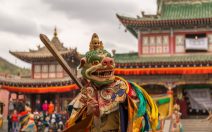In Tibetan it’s called Tashitakgyad, The eight auspicious symbols are the most well known group of Buddhist Symbols, and are traditionally listed in the order of : 1). White Parasol ; 2), a pair of golden fish ; 3), a treasure vast; 4). A lotus ; 5), a conch shell ; 6), Enless Knot or Lucky Diagram ; 7) , a victorious banner ; 8), a golden wheel.
In the Buddhist tradition these eight symbols of good fortune represent the offerings of presented by the great Vedic gods to Shakyamuni Buddha upon his attainment of enlightenment.
The parasol or umbrella, is a traditional symbol of royalty and protection. The dome of the parasol represent wisdom, and it’s hanging silk valances the various methods of compassion or skillful means. The white parasol that was presented to the Buddha essentially symbolizes his ability to protect all beings from delusions and fears.
The Golden Fish, represent happiness and spontaneity, as the they have complete freedom of movement in the water.
The Treasure Vase, or vase of inexhaustible treasure, is represented as a highly ornate golden vas, with lotus sections. A single wish-granting gem or a group of three gems, seals it’s upper rim as a symbol of the Three Jewels of the Buddha, Dharma and Sanga.
The Lotus, which grows from the dark watery mire but is unstained by it, is a major Buddhist symbol of purity and renunciation. It represents the blossoming of the wholesome activities, which are performed with complete free from the faults of cyclic existence. The Lotus seats upon which deities sit or stand symbolizes their divine origin. They are immaculately conceived, innately perfect, and absolutely pure in their body, speech and mind.
The Conch Shell, is usually depicted vertically, often with a silk ribbon threaded through it’s lower extremity. Its right spiral is indicated by the curve and aperture of it’s mouth, which faces towards the right. The couch may also appear as a horizontally positioned receptacle for aromatic liquids or perfumes. As a hand-held attribute, symbolizing the proclamation of the Buddhadarma as the aspect of speech, the couch is usually held in the left wisdom hand of deities.
The Endless Knot, represents the Buddha’s endless wisdom and compassion. As a symbol of Buddha’s teaching it represents the continuity of the twelve links of dependent origination, which underlies the reality of cyclic existence.
The Victory Banner, within the Tibetan tradition a list of eleven different forms of the victory banner is given to represent elven specific methods for overcoming defilement.
The Wheel, also known as the wheel of darma, represents the Buddha’s teaching. The wheel’s swift motion represents the rapid spiritual transformationrevealed in the Buddha’s teachings.





